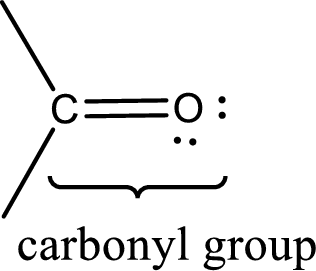
Concept explainers
Interpretation:
Among the given statements, the one which is true when boiling points of
Concept Introduction:
Carbonyl groups are the one which contain a double bond between carbon and oxygen atom. Aldehydes and ketones possess this carbonyl

Aldehydes contain a carbonyl group that contains a hydrogen atom and a carbon atom bonded to it. Aldehyde that has one and two carbon atoms are gas at room temperature. The physical state of aldehyde that contains three carbon atoms to eleven carbon atoms that are not branched is liquid at room temperature. Aldehydes that contain more than eleven carbon atoms are solid at room temperature.
Ketones contain a carbonyl group that contains two carbon atoms bonded to it. For a compound to be ketone, a minimum of three carbon atom is required. Ketones that contain three carbon atoms to eight carbon atoms which have the carbonyl group at the second carbon atom are liquid at room temperature.
Boiling point is the temperature at which the liquid state gets converted into gaseous state. Aldehydes and ketones have their boiling points intermediate between the boiling points of alcohols and
Trending nowThis is a popular solution!

Chapter 4 Solutions
Organic And Biological Chemistry
- What is the product of the reaction? F3C. CF3 OMe NaOH / H₂Oarrow_forwardWhat would you expect to be the major product obtained from the following reaction? Please explain what is happening here. Provide a detailed explanation and a drawing showing how the reaction occurs. The correct answer to this question is V.arrow_forwardPlease answer the question for the reactions, thank youarrow_forward
- What is the product of the following reaction? Please include a detailed explanation of what is happening in this question. Include a drawing showing how the reagent is reacting with the catalyst to produce the correct product. The correct answer is IV.arrow_forwardPlease complete the reactions, thank youarrow_forwardConsider the synthesis. What is compound Y? Please explain what is happening in this question. Provide a detailed explanation and a drawing to show how the compound Y creates the product. The correct answer is D.arrow_forward
- What would be the major product of the following reaction? Please include a detailed explanation of what is happening in this question. Include steps and a drawing to show this reaction proceeds and how the final product is formed. The correct answer is B. I put answer D and I don't really understand what is going on in the question.arrow_forwardWhat is the product of the following reaction? Please explain what is happening in this question. Provide a detailed explanation and a drawing showing how the reagent is reacting with the catalysts to product the correct product. The correct answer is B.arrow_forwardWhat is the missing intermediate 1 and the final product 2. Please include a detailed explanation explaining the steps of malonic ester synthesis. Please include drawings of the intermediate and how it occurs and how the final product is former.arrow_forward
 Organic And Biological ChemistryChemistryISBN:9781305081079Author:STOKER, H. Stephen (howard Stephen)Publisher:Cengage Learning,
Organic And Biological ChemistryChemistryISBN:9781305081079Author:STOKER, H. Stephen (howard Stephen)Publisher:Cengage Learning, General, Organic, and Biological ChemistryChemistryISBN:9781285853918Author:H. Stephen StokerPublisher:Cengage Learning
General, Organic, and Biological ChemistryChemistryISBN:9781285853918Author:H. Stephen StokerPublisher:Cengage Learning

